Gender Roles and Societal Expectations in Ibsen's A Doll's House
VerifiedAdded on 2023/05/28
|8
|2482
|402
Essay
AI Summary
This essay provides a comprehensive analysis of gender roles in Henrik Ibsen's play, 'A Doll's House.' It explores the dynamics between the characters, particularly Nora and Torvald Helmer, within the context of the patriarchal Victorian society. The essay examines how the characters' behaviors are influenced by societal expectations and gender stereotypes. It delves into the themes of marriage, power, and the struggle for female identity. The essay highlights the play's feminist undertones and the eventual role reversal, emphasizing the characters' traits as determined by their inherent qualities, not by their genders. The essay also examines the play's impact on contemporary culture and its portrayal of the characters' emotions and weaknesses. Through a detailed examination of the characters and their interactions, the essay reveals Ibsen's critique of societal norms and his advocacy for individual freedom and self-discovery.

Running head: GENDER ROLES IN A DOLL'S HOUSE
GENDER ROLES IN A DOLL'S HOUSE
Name of the Student
Name of the University
Author Note
GENDER ROLES IN A DOLL'S HOUSE
Name of the Student
Name of the University
Author Note
Paraphrase This Document
Need a fresh take? Get an instant paraphrase of this document with our AI Paraphraser
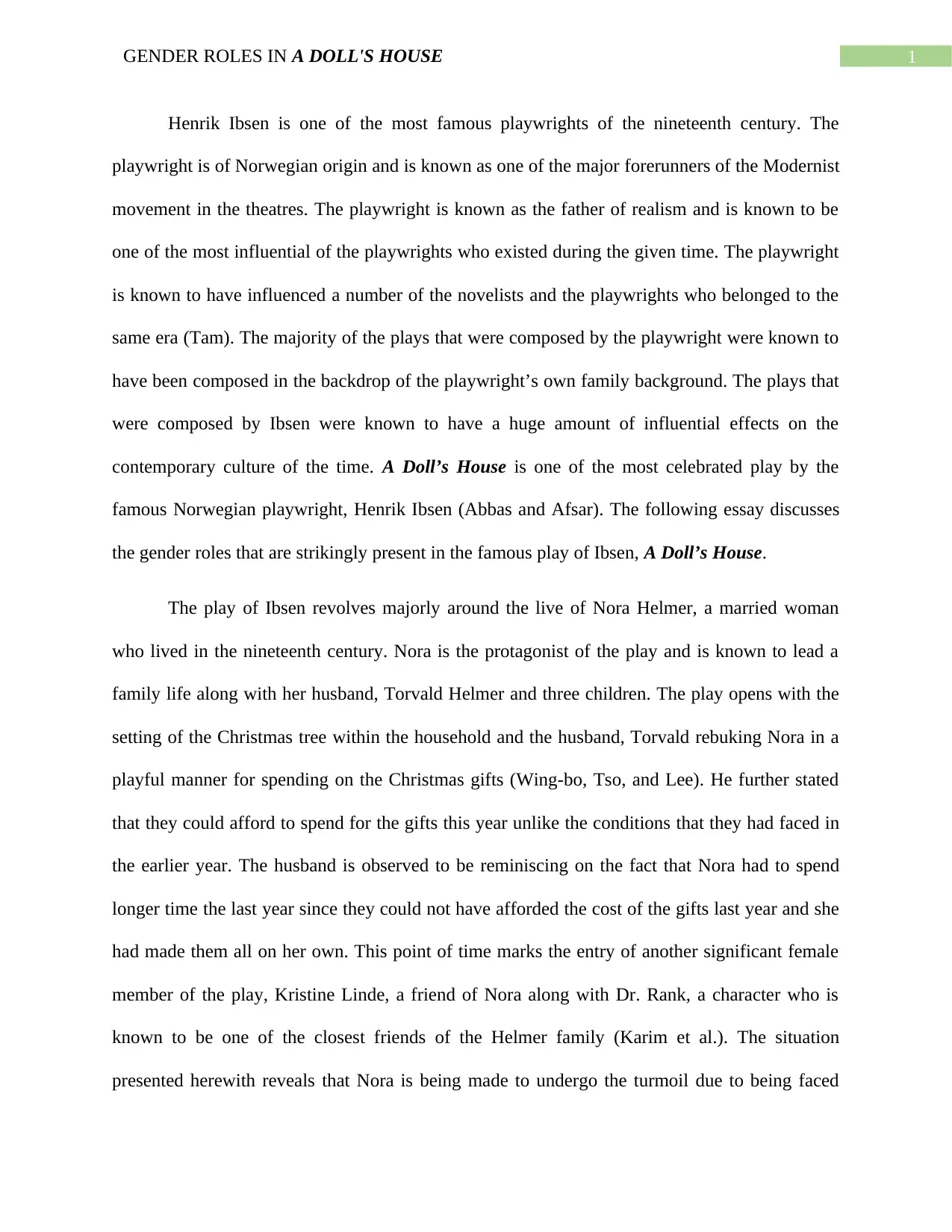
1GENDER ROLES IN A DOLL'S HOUSE
Henrik Ibsen is one of the most famous playwrights of the nineteenth century. The
playwright is of Norwegian origin and is known as one of the major forerunners of the Modernist
movement in the theatres. The playwright is known as the father of realism and is known to be
one of the most influential of the playwrights who existed during the given time. The playwright
is known to have influenced a number of the novelists and the playwrights who belonged to the
same era (Tam). The majority of the plays that were composed by the playwright were known to
have been composed in the backdrop of the playwright’s own family background. The plays that
were composed by Ibsen were known to have a huge amount of influential effects on the
contemporary culture of the time. A Doll’s House is one of the most celebrated play by the
famous Norwegian playwright, Henrik Ibsen (Abbas and Afsar). The following essay discusses
the gender roles that are strikingly present in the famous play of Ibsen, A Doll’s House.
The play of Ibsen revolves majorly around the live of Nora Helmer, a married woman
who lived in the nineteenth century. Nora is the protagonist of the play and is known to lead a
family life along with her husband, Torvald Helmer and three children. The play opens with the
setting of the Christmas tree within the household and the husband, Torvald rebuking Nora in a
playful manner for spending on the Christmas gifts (Wing-bo, Tso, and Lee). He further stated
that they could afford to spend for the gifts this year unlike the conditions that they had faced in
the earlier year. The husband is observed to be reminiscing on the fact that Nora had to spend
longer time the last year since they could not have afforded the cost of the gifts last year and she
had made them all on her own. This point of time marks the entry of another significant female
member of the play, Kristine Linde, a friend of Nora along with Dr. Rank, a character who is
known to be one of the closest friends of the Helmer family (Karim et al.). The situation
presented herewith reveals that Nora is being made to undergo the turmoil due to being faced
Henrik Ibsen is one of the most famous playwrights of the nineteenth century. The
playwright is of Norwegian origin and is known as one of the major forerunners of the Modernist
movement in the theatres. The playwright is known as the father of realism and is known to be
one of the most influential of the playwrights who existed during the given time. The playwright
is known to have influenced a number of the novelists and the playwrights who belonged to the
same era (Tam). The majority of the plays that were composed by the playwright were known to
have been composed in the backdrop of the playwright’s own family background. The plays that
were composed by Ibsen were known to have a huge amount of influential effects on the
contemporary culture of the time. A Doll’s House is one of the most celebrated play by the
famous Norwegian playwright, Henrik Ibsen (Abbas and Afsar). The following essay discusses
the gender roles that are strikingly present in the famous play of Ibsen, A Doll’s House.
The play of Ibsen revolves majorly around the live of Nora Helmer, a married woman
who lived in the nineteenth century. Nora is the protagonist of the play and is known to lead a
family life along with her husband, Torvald Helmer and three children. The play opens with the
setting of the Christmas tree within the household and the husband, Torvald rebuking Nora in a
playful manner for spending on the Christmas gifts (Wing-bo, Tso, and Lee). He further stated
that they could afford to spend for the gifts this year unlike the conditions that they had faced in
the earlier year. The husband is observed to be reminiscing on the fact that Nora had to spend
longer time the last year since they could not have afforded the cost of the gifts last year and she
had made them all on her own. This point of time marks the entry of another significant female
member of the play, Kristine Linde, a friend of Nora along with Dr. Rank, a character who is
known to be one of the closest friends of the Helmer family (Karim et al.). The situation
presented herewith reveals that Nora is being made to undergo the turmoil due to being faced
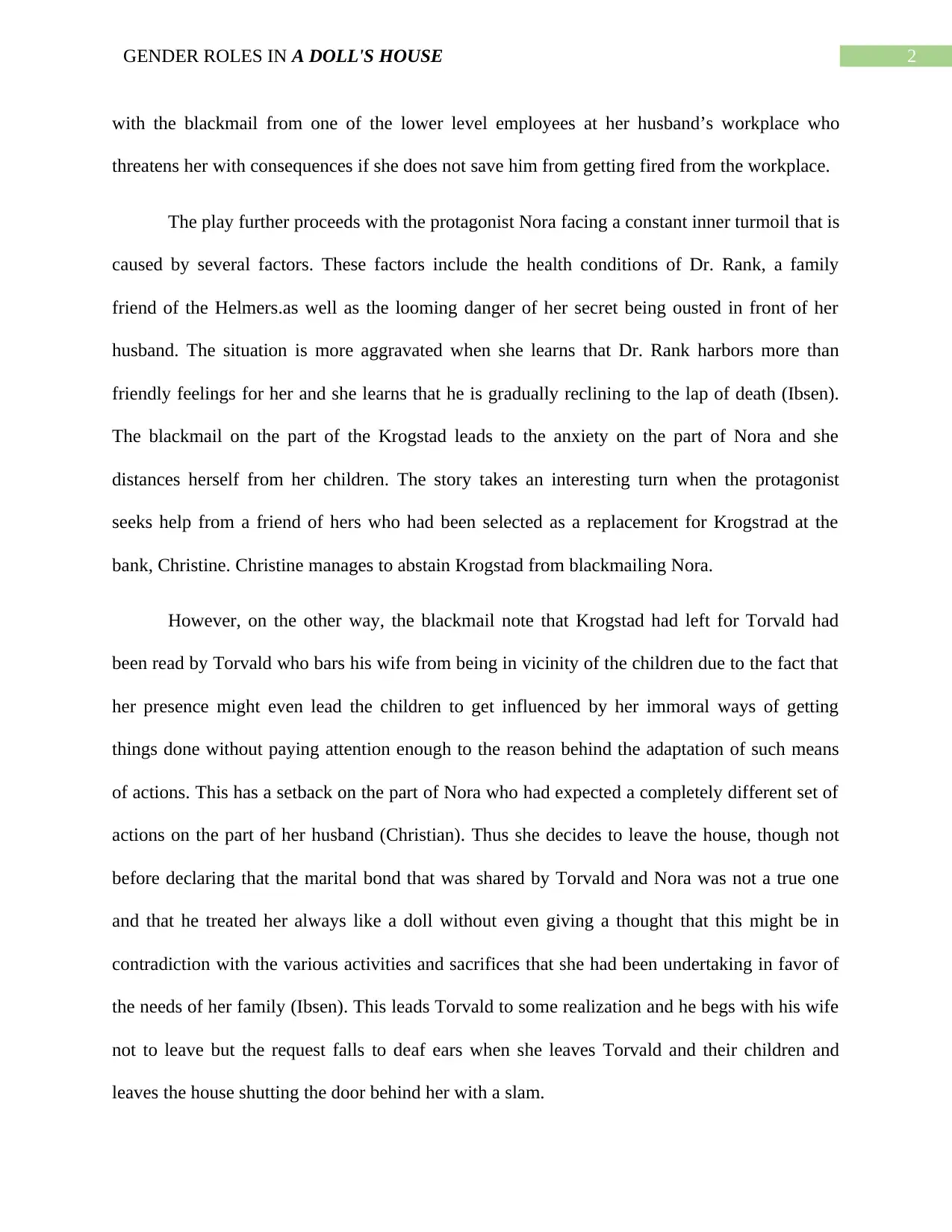
2GENDER ROLES IN A DOLL'S HOUSE
with the blackmail from one of the lower level employees at her husband’s workplace who
threatens her with consequences if she does not save him from getting fired from the workplace.
The play further proceeds with the protagonist Nora facing a constant inner turmoil that is
caused by several factors. These factors include the health conditions of Dr. Rank, a family
friend of the Helmers.as well as the looming danger of her secret being ousted in front of her
husband. The situation is more aggravated when she learns that Dr. Rank harbors more than
friendly feelings for her and she learns that he is gradually reclining to the lap of death (Ibsen).
The blackmail on the part of the Krogstad leads to the anxiety on the part of Nora and she
distances herself from her children. The story takes an interesting turn when the protagonist
seeks help from a friend of hers who had been selected as a replacement for Krogstrad at the
bank, Christine. Christine manages to abstain Krogstad from blackmailing Nora.
However, on the other way, the blackmail note that Krogstad had left for Torvald had
been read by Torvald who bars his wife from being in vicinity of the children due to the fact that
her presence might even lead the children to get influenced by her immoral ways of getting
things done without paying attention enough to the reason behind the adaptation of such means
of actions. This has a setback on the part of Nora who had expected a completely different set of
actions on the part of her husband (Christian). Thus she decides to leave the house, though not
before declaring that the marital bond that was shared by Torvald and Nora was not a true one
and that he treated her always like a doll without even giving a thought that this might be in
contradiction with the various activities and sacrifices that she had been undertaking in favor of
the needs of her family (Ibsen). This leads Torvald to some realization and he begs with his wife
not to leave but the request falls to deaf ears when she leaves Torvald and their children and
leaves the house shutting the door behind her with a slam.
with the blackmail from one of the lower level employees at her husband’s workplace who
threatens her with consequences if she does not save him from getting fired from the workplace.
The play further proceeds with the protagonist Nora facing a constant inner turmoil that is
caused by several factors. These factors include the health conditions of Dr. Rank, a family
friend of the Helmers.as well as the looming danger of her secret being ousted in front of her
husband. The situation is more aggravated when she learns that Dr. Rank harbors more than
friendly feelings for her and she learns that he is gradually reclining to the lap of death (Ibsen).
The blackmail on the part of the Krogstad leads to the anxiety on the part of Nora and she
distances herself from her children. The story takes an interesting turn when the protagonist
seeks help from a friend of hers who had been selected as a replacement for Krogstrad at the
bank, Christine. Christine manages to abstain Krogstad from blackmailing Nora.
However, on the other way, the blackmail note that Krogstad had left for Torvald had
been read by Torvald who bars his wife from being in vicinity of the children due to the fact that
her presence might even lead the children to get influenced by her immoral ways of getting
things done without paying attention enough to the reason behind the adaptation of such means
of actions. This has a setback on the part of Nora who had expected a completely different set of
actions on the part of her husband (Christian). Thus she decides to leave the house, though not
before declaring that the marital bond that was shared by Torvald and Nora was not a true one
and that he treated her always like a doll without even giving a thought that this might be in
contradiction with the various activities and sacrifices that she had been undertaking in favor of
the needs of her family (Ibsen). This leads Torvald to some realization and he begs with his wife
not to leave but the request falls to deaf ears when she leaves Torvald and their children and
leaves the house shutting the door behind her with a slam.
⊘ This is a preview!⊘
Do you want full access?
Subscribe today to unlock all pages.

Trusted by 1+ million students worldwide
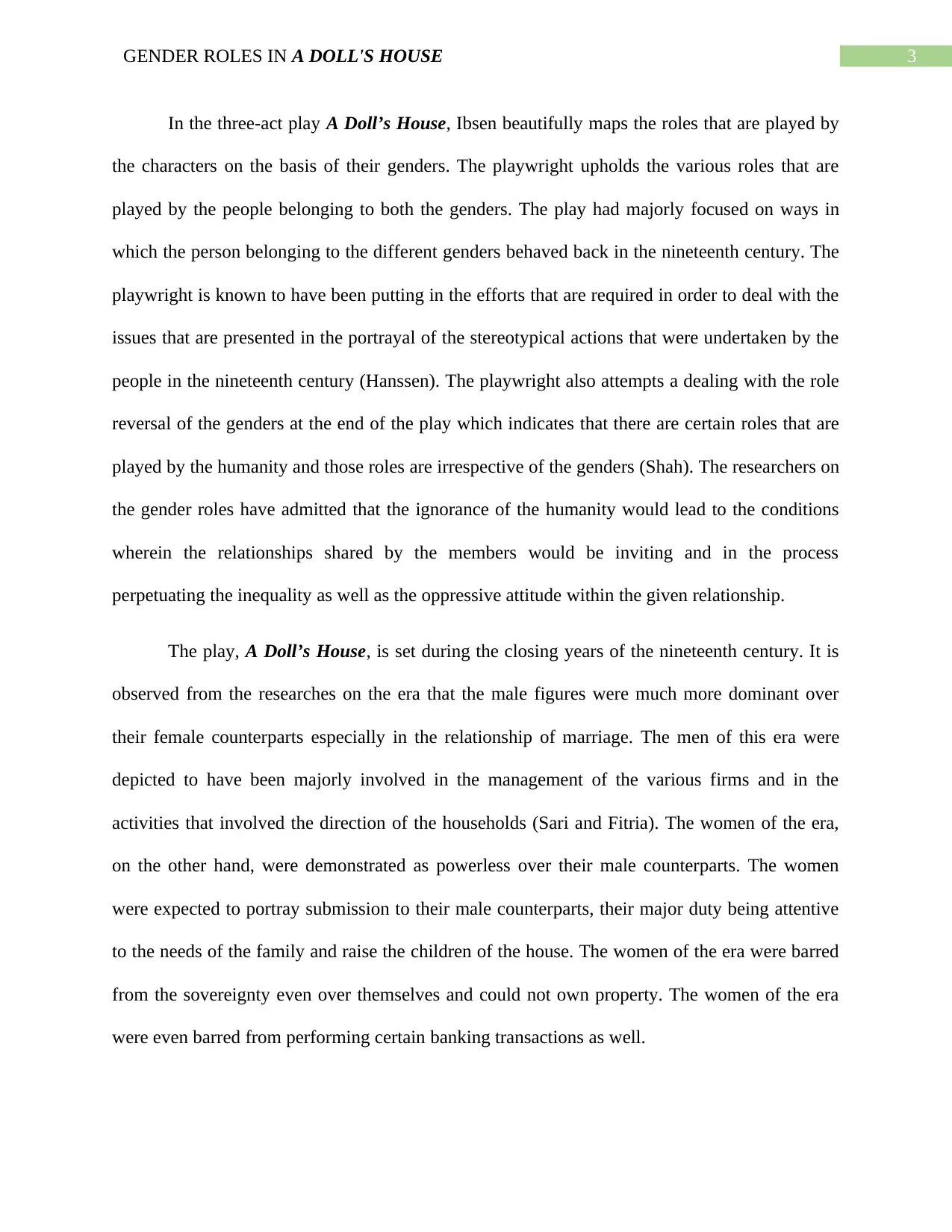
3GENDER ROLES IN A DOLL'S HOUSE
In the three-act play A Doll’s House, Ibsen beautifully maps the roles that are played by
the characters on the basis of their genders. The playwright upholds the various roles that are
played by the people belonging to both the genders. The play had majorly focused on ways in
which the person belonging to the different genders behaved back in the nineteenth century. The
playwright is known to have been putting in the efforts that are required in order to deal with the
issues that are presented in the portrayal of the stereotypical actions that were undertaken by the
people in the nineteenth century (Hanssen). The playwright also attempts a dealing with the role
reversal of the genders at the end of the play which indicates that there are certain roles that are
played by the humanity and those roles are irrespective of the genders (Shah). The researchers on
the gender roles have admitted that the ignorance of the humanity would lead to the conditions
wherein the relationships shared by the members would be inviting and in the process
perpetuating the inequality as well as the oppressive attitude within the given relationship.
The play, A Doll’s House, is set during the closing years of the nineteenth century. It is
observed from the researches on the era that the male figures were much more dominant over
their female counterparts especially in the relationship of marriage. The men of this era were
depicted to have been majorly involved in the management of the various firms and in the
activities that involved the direction of the households (Sari and Fitria). The women of the era,
on the other hand, were demonstrated as powerless over their male counterparts. The women
were expected to portray submission to their male counterparts, their major duty being attentive
to the needs of the family and raise the children of the house. The women of the era were barred
from the sovereignty even over themselves and could not own property. The women of the era
were even barred from performing certain banking transactions as well.
In the three-act play A Doll’s House, Ibsen beautifully maps the roles that are played by
the characters on the basis of their genders. The playwright upholds the various roles that are
played by the people belonging to both the genders. The play had majorly focused on ways in
which the person belonging to the different genders behaved back in the nineteenth century. The
playwright is known to have been putting in the efforts that are required in order to deal with the
issues that are presented in the portrayal of the stereotypical actions that were undertaken by the
people in the nineteenth century (Hanssen). The playwright also attempts a dealing with the role
reversal of the genders at the end of the play which indicates that there are certain roles that are
played by the humanity and those roles are irrespective of the genders (Shah). The researchers on
the gender roles have admitted that the ignorance of the humanity would lead to the conditions
wherein the relationships shared by the members would be inviting and in the process
perpetuating the inequality as well as the oppressive attitude within the given relationship.
The play, A Doll’s House, is set during the closing years of the nineteenth century. It is
observed from the researches on the era that the male figures were much more dominant over
their female counterparts especially in the relationship of marriage. The men of this era were
depicted to have been majorly involved in the management of the various firms and in the
activities that involved the direction of the households (Sari and Fitria). The women of the era,
on the other hand, were demonstrated as powerless over their male counterparts. The women
were expected to portray submission to their male counterparts, their major duty being attentive
to the needs of the family and raise the children of the house. The women of the era were barred
from the sovereignty even over themselves and could not own property. The women of the era
were even barred from performing certain banking transactions as well.
Paraphrase This Document
Need a fresh take? Get an instant paraphrase of this document with our AI Paraphraser
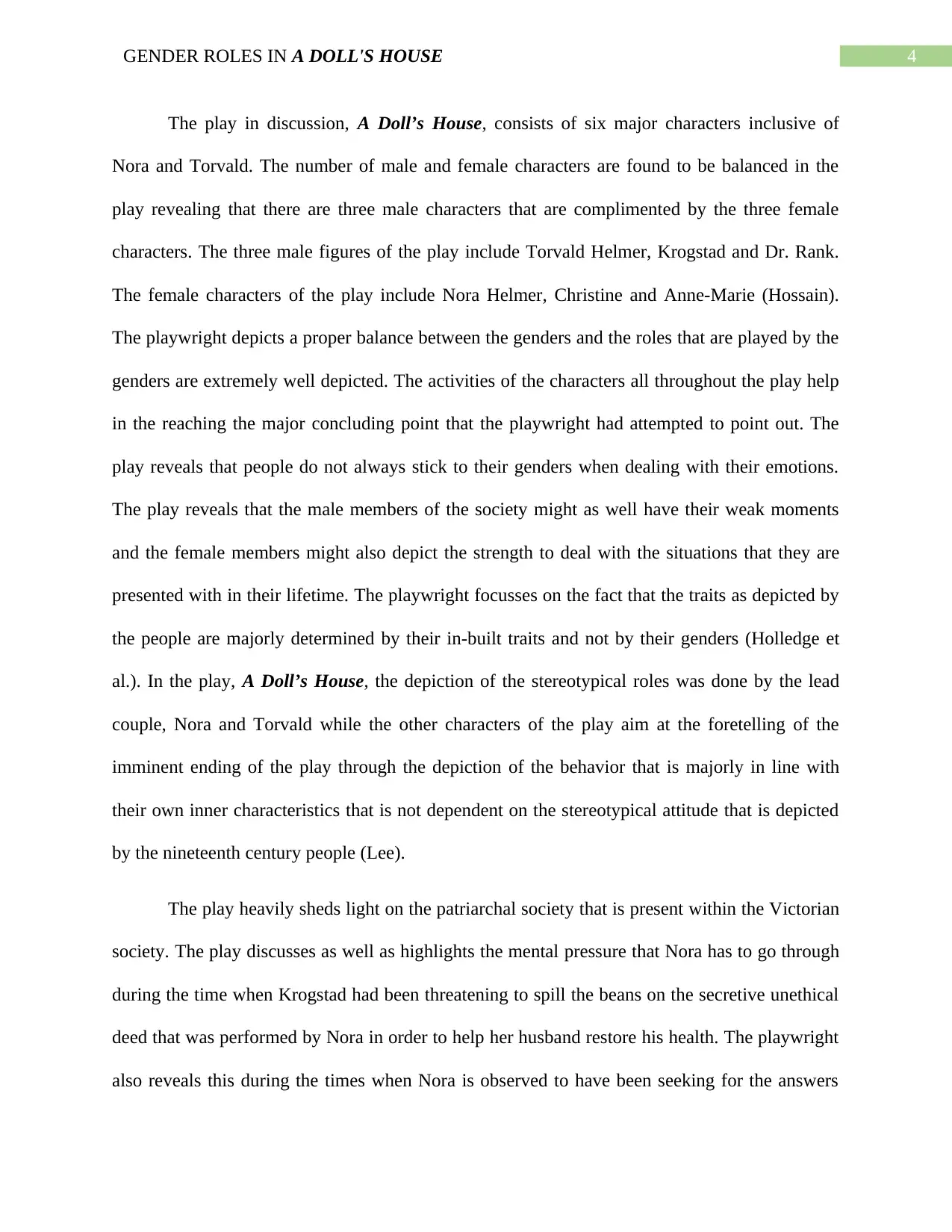
4GENDER ROLES IN A DOLL'S HOUSE
The play in discussion, A Doll’s House, consists of six major characters inclusive of
Nora and Torvald. The number of male and female characters are found to be balanced in the
play revealing that there are three male characters that are complimented by the three female
characters. The three male figures of the play include Torvald Helmer, Krogstad and Dr. Rank.
The female characters of the play include Nora Helmer, Christine and Anne-Marie (Hossain).
The playwright depicts a proper balance between the genders and the roles that are played by the
genders are extremely well depicted. The activities of the characters all throughout the play help
in the reaching the major concluding point that the playwright had attempted to point out. The
play reveals that people do not always stick to their genders when dealing with their emotions.
The play reveals that the male members of the society might as well have their weak moments
and the female members might also depict the strength to deal with the situations that they are
presented with in their lifetime. The playwright focusses on the fact that the traits as depicted by
the people are majorly determined by their in-built traits and not by their genders (Holledge et
al.). In the play, A Doll’s House, the depiction of the stereotypical roles was done by the lead
couple, Nora and Torvald while the other characters of the play aim at the foretelling of the
imminent ending of the play through the depiction of the behavior that is majorly in line with
their own inner characteristics that is not dependent on the stereotypical attitude that is depicted
by the nineteenth century people (Lee).
The play heavily sheds light on the patriarchal society that is present within the Victorian
society. The play discusses as well as highlights the mental pressure that Nora has to go through
during the time when Krogstad had been threatening to spill the beans on the secretive unethical
deed that was performed by Nora in order to help her husband restore his health. The playwright
also reveals this during the times when Nora is observed to have been seeking for the answers
The play in discussion, A Doll’s House, consists of six major characters inclusive of
Nora and Torvald. The number of male and female characters are found to be balanced in the
play revealing that there are three male characters that are complimented by the three female
characters. The three male figures of the play include Torvald Helmer, Krogstad and Dr. Rank.
The female characters of the play include Nora Helmer, Christine and Anne-Marie (Hossain).
The playwright depicts a proper balance between the genders and the roles that are played by the
genders are extremely well depicted. The activities of the characters all throughout the play help
in the reaching the major concluding point that the playwright had attempted to point out. The
play reveals that people do not always stick to their genders when dealing with their emotions.
The play reveals that the male members of the society might as well have their weak moments
and the female members might also depict the strength to deal with the situations that they are
presented with in their lifetime. The playwright focusses on the fact that the traits as depicted by
the people are majorly determined by their in-built traits and not by their genders (Holledge et
al.). In the play, A Doll’s House, the depiction of the stereotypical roles was done by the lead
couple, Nora and Torvald while the other characters of the play aim at the foretelling of the
imminent ending of the play through the depiction of the behavior that is majorly in line with
their own inner characteristics that is not dependent on the stereotypical attitude that is depicted
by the nineteenth century people (Lee).
The play heavily sheds light on the patriarchal society that is present within the Victorian
society. The play discusses as well as highlights the mental pressure that Nora has to go through
during the time when Krogstad had been threatening to spill the beans on the secretive unethical
deed that was performed by Nora in order to help her husband restore his health. The playwright
also reveals this during the times when Nora is observed to have been seeking for the answers
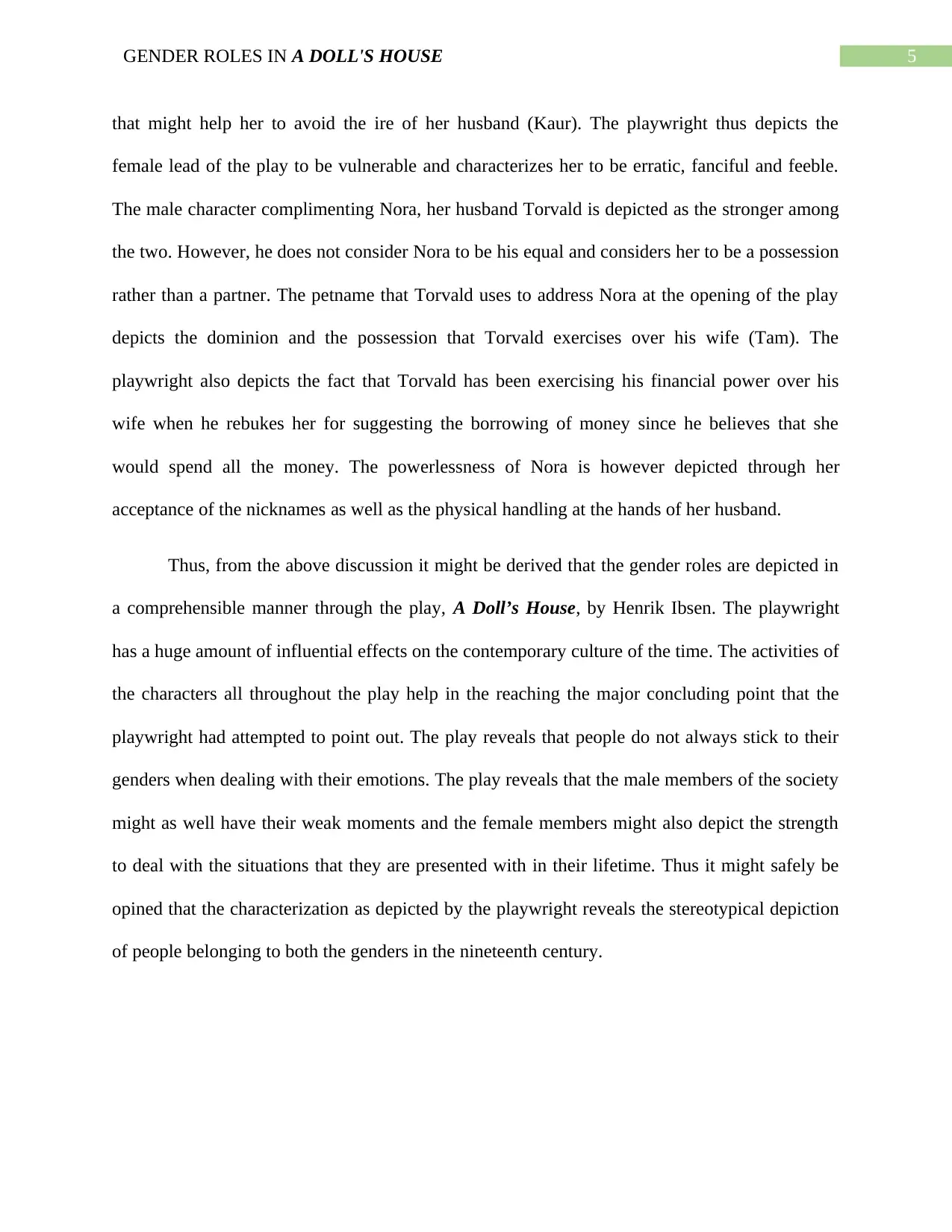
5GENDER ROLES IN A DOLL'S HOUSE
that might help her to avoid the ire of her husband (Kaur). The playwright thus depicts the
female lead of the play to be vulnerable and characterizes her to be erratic, fanciful and feeble.
The male character complimenting Nora, her husband Torvald is depicted as the stronger among
the two. However, he does not consider Nora to be his equal and considers her to be a possession
rather than a partner. The petname that Torvald uses to address Nora at the opening of the play
depicts the dominion and the possession that Torvald exercises over his wife (Tam). The
playwright also depicts the fact that Torvald has been exercising his financial power over his
wife when he rebukes her for suggesting the borrowing of money since he believes that she
would spend all the money. The powerlessness of Nora is however depicted through her
acceptance of the nicknames as well as the physical handling at the hands of her husband.
Thus, from the above discussion it might be derived that the gender roles are depicted in
a comprehensible manner through the play, A Doll’s House, by Henrik Ibsen. The playwright
has a huge amount of influential effects on the contemporary culture of the time. The activities of
the characters all throughout the play help in the reaching the major concluding point that the
playwright had attempted to point out. The play reveals that people do not always stick to their
genders when dealing with their emotions. The play reveals that the male members of the society
might as well have their weak moments and the female members might also depict the strength
to deal with the situations that they are presented with in their lifetime. Thus it might safely be
opined that the characterization as depicted by the playwright reveals the stereotypical depiction
of people belonging to both the genders in the nineteenth century.
that might help her to avoid the ire of her husband (Kaur). The playwright thus depicts the
female lead of the play to be vulnerable and characterizes her to be erratic, fanciful and feeble.
The male character complimenting Nora, her husband Torvald is depicted as the stronger among
the two. However, he does not consider Nora to be his equal and considers her to be a possession
rather than a partner. The petname that Torvald uses to address Nora at the opening of the play
depicts the dominion and the possession that Torvald exercises over his wife (Tam). The
playwright also depicts the fact that Torvald has been exercising his financial power over his
wife when he rebukes her for suggesting the borrowing of money since he believes that she
would spend all the money. The powerlessness of Nora is however depicted through her
acceptance of the nicknames as well as the physical handling at the hands of her husband.
Thus, from the above discussion it might be derived that the gender roles are depicted in
a comprehensible manner through the play, A Doll’s House, by Henrik Ibsen. The playwright
has a huge amount of influential effects on the contemporary culture of the time. The activities of
the characters all throughout the play help in the reaching the major concluding point that the
playwright had attempted to point out. The play reveals that people do not always stick to their
genders when dealing with their emotions. The play reveals that the male members of the society
might as well have their weak moments and the female members might also depict the strength
to deal with the situations that they are presented with in their lifetime. Thus it might safely be
opined that the characterization as depicted by the playwright reveals the stereotypical depiction
of people belonging to both the genders in the nineteenth century.
⊘ This is a preview!⊘
Do you want full access?
Subscribe today to unlock all pages.

Trusted by 1+ million students worldwide
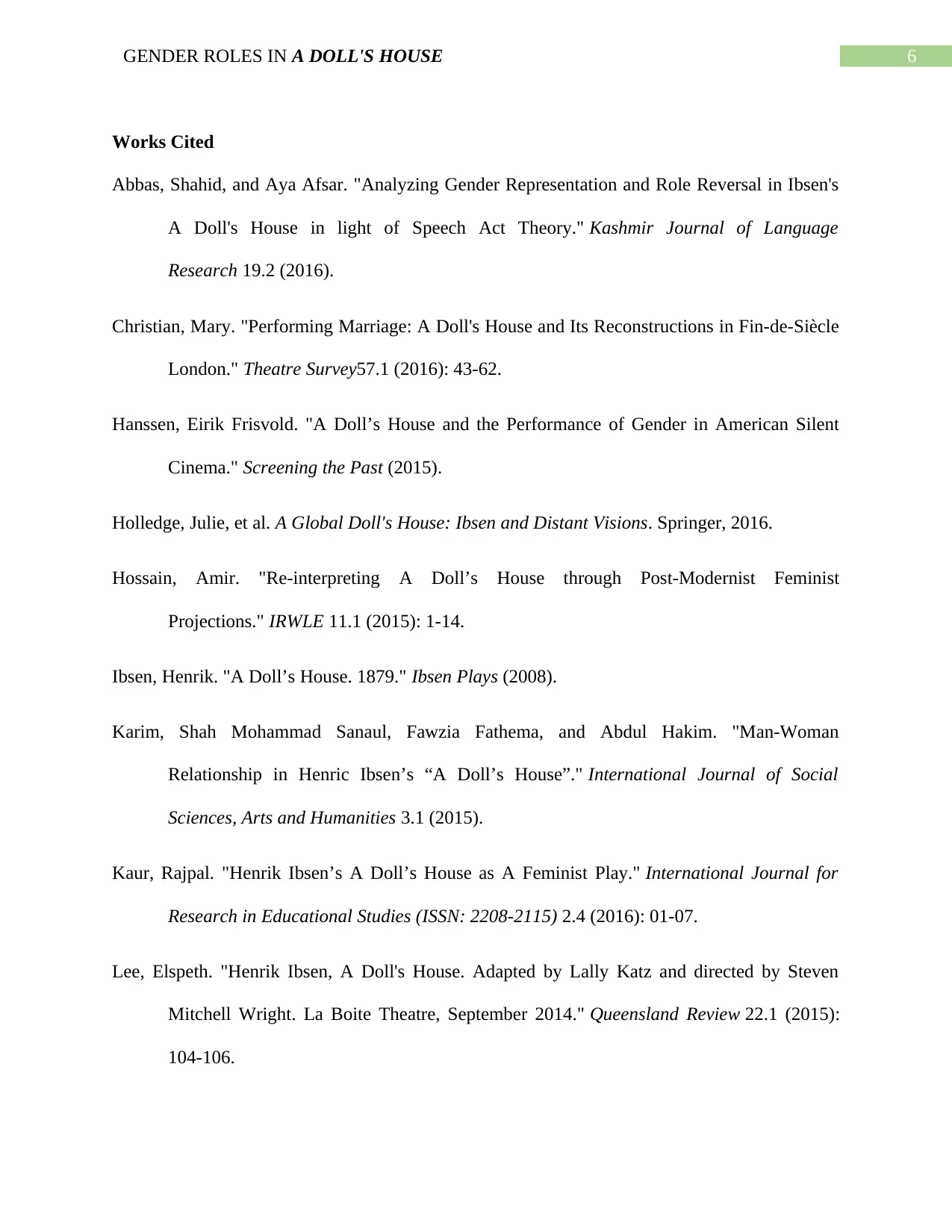
6GENDER ROLES IN A DOLL'S HOUSE
Works Cited
Abbas, Shahid, and Aya Afsar. "Analyzing Gender Representation and Role Reversal in Ibsen's
A Doll's House in light of Speech Act Theory." Kashmir Journal of Language
Research 19.2 (2016).
Christian, Mary. "Performing Marriage: A Doll's House and Its Reconstructions in Fin-de-Siècle
London." Theatre Survey57.1 (2016): 43-62.
Hanssen, Eirik Frisvold. "A Doll’s House and the Performance of Gender in American Silent
Cinema." Screening the Past (2015).
Holledge, Julie, et al. A Global Doll's House: Ibsen and Distant Visions. Springer, 2016.
Hossain, Amir. "Re-interpreting A Doll’s House through Post-Modernist Feminist
Projections." IRWLE 11.1 (2015): 1-14.
Ibsen, Henrik. "A Doll’s House. 1879." Ibsen Plays (2008).
Karim, Shah Mohammad Sanaul, Fawzia Fathema, and Abdul Hakim. "Man-Woman
Relationship in Henric Ibsen’s “A Doll’s House”." International Journal of Social
Sciences, Arts and Humanities 3.1 (2015).
Kaur, Rajpal. "Henrik Ibsen’s A Doll’s House as A Feminist Play." International Journal for
Research in Educational Studies (ISSN: 2208-2115) 2.4 (2016): 01-07.
Lee, Elspeth. "Henrik Ibsen, A Doll's House. Adapted by Lally Katz and directed by Steven
Mitchell Wright. La Boite Theatre, September 2014." Queensland Review 22.1 (2015):
104-106.
Works Cited
Abbas, Shahid, and Aya Afsar. "Analyzing Gender Representation and Role Reversal in Ibsen's
A Doll's House in light of Speech Act Theory." Kashmir Journal of Language
Research 19.2 (2016).
Christian, Mary. "Performing Marriage: A Doll's House and Its Reconstructions in Fin-de-Siècle
London." Theatre Survey57.1 (2016): 43-62.
Hanssen, Eirik Frisvold. "A Doll’s House and the Performance of Gender in American Silent
Cinema." Screening the Past (2015).
Holledge, Julie, et al. A Global Doll's House: Ibsen and Distant Visions. Springer, 2016.
Hossain, Amir. "Re-interpreting A Doll’s House through Post-Modernist Feminist
Projections." IRWLE 11.1 (2015): 1-14.
Ibsen, Henrik. "A Doll’s House. 1879." Ibsen Plays (2008).
Karim, Shah Mohammad Sanaul, Fawzia Fathema, and Abdul Hakim. "Man-Woman
Relationship in Henric Ibsen’s “A Doll’s House”." International Journal of Social
Sciences, Arts and Humanities 3.1 (2015).
Kaur, Rajpal. "Henrik Ibsen’s A Doll’s House as A Feminist Play." International Journal for
Research in Educational Studies (ISSN: 2208-2115) 2.4 (2016): 01-07.
Lee, Elspeth. "Henrik Ibsen, A Doll's House. Adapted by Lally Katz and directed by Steven
Mitchell Wright. La Boite Theatre, September 2014." Queensland Review 22.1 (2015):
104-106.
Paraphrase This Document
Need a fresh take? Get an instant paraphrase of this document with our AI Paraphraser
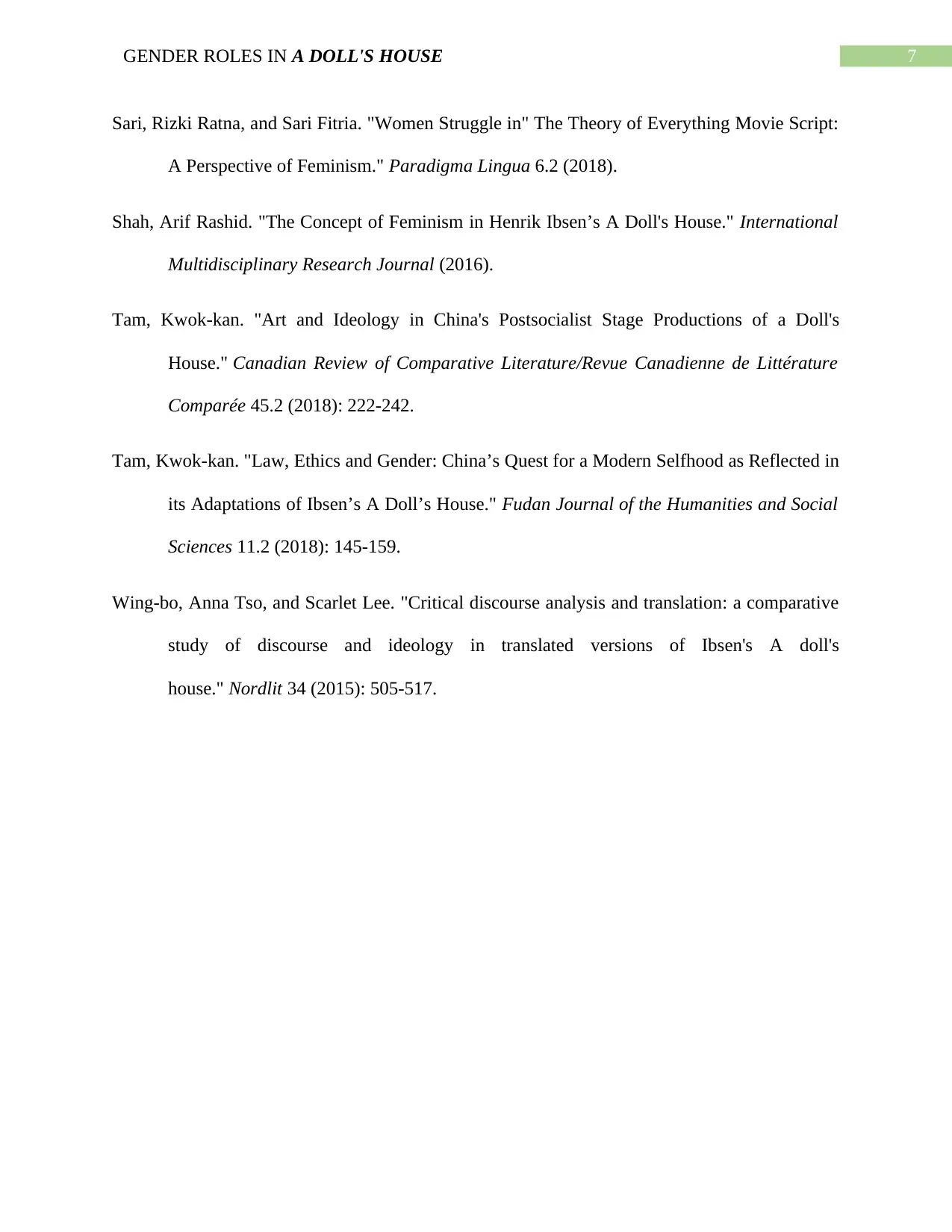
7GENDER ROLES IN A DOLL'S HOUSE
Sari, Rizki Ratna, and Sari Fitria. "Women Struggle in" The Theory of Everything Movie Script:
A Perspective of Feminism." Paradigma Lingua 6.2 (2018).
Shah, Arif Rashid. "The Concept of Feminism in Henrik Ibsen’s A Doll's House." International
Multidisciplinary Research Journal (2016).
Tam, Kwok-kan. "Art and Ideology in China's Postsocialist Stage Productions of a Doll's
House." Canadian Review of Comparative Literature/Revue Canadienne de Littérature
Comparée 45.2 (2018): 222-242.
Tam, Kwok-kan. "Law, Ethics and Gender: China’s Quest for a Modern Selfhood as Reflected in
its Adaptations of Ibsen’s A Doll’s House." Fudan Journal of the Humanities and Social
Sciences 11.2 (2018): 145-159.
Wing-bo, Anna Tso, and Scarlet Lee. "Critical discourse analysis and translation: a comparative
study of discourse and ideology in translated versions of Ibsen's A doll's
house." Nordlit 34 (2015): 505-517.
Sari, Rizki Ratna, and Sari Fitria. "Women Struggle in" The Theory of Everything Movie Script:
A Perspective of Feminism." Paradigma Lingua 6.2 (2018).
Shah, Arif Rashid. "The Concept of Feminism in Henrik Ibsen’s A Doll's House." International
Multidisciplinary Research Journal (2016).
Tam, Kwok-kan. "Art and Ideology in China's Postsocialist Stage Productions of a Doll's
House." Canadian Review of Comparative Literature/Revue Canadienne de Littérature
Comparée 45.2 (2018): 222-242.
Tam, Kwok-kan. "Law, Ethics and Gender: China’s Quest for a Modern Selfhood as Reflected in
its Adaptations of Ibsen’s A Doll’s House." Fudan Journal of the Humanities and Social
Sciences 11.2 (2018): 145-159.
Wing-bo, Anna Tso, and Scarlet Lee. "Critical discourse analysis and translation: a comparative
study of discourse and ideology in translated versions of Ibsen's A doll's
house." Nordlit 34 (2015): 505-517.
1 out of 8
Related Documents
Your All-in-One AI-Powered Toolkit for Academic Success.
+13062052269
info@desklib.com
Available 24*7 on WhatsApp / Email
![[object Object]](/_next/static/media/star-bottom.7253800d.svg)
Unlock your academic potential
Copyright © 2020–2025 A2Z Services. All Rights Reserved. Developed and managed by ZUCOL.





